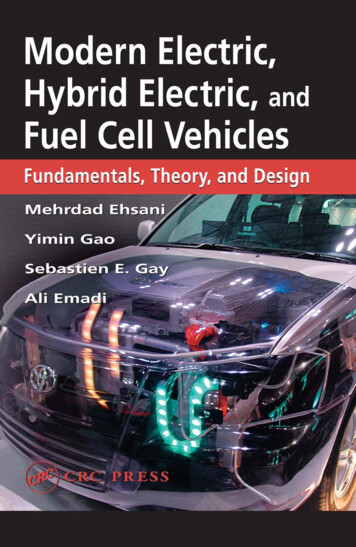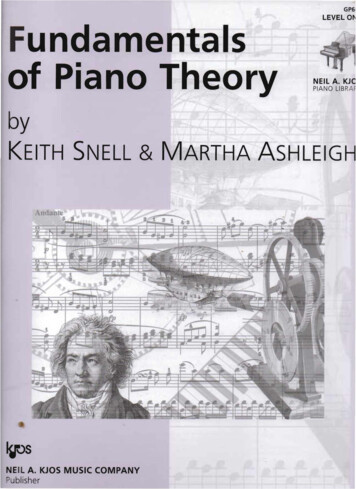
Transcription
Modern Electric,Hybrid Electric, andFuel Cell VehiclesFundamentals, Theory, and Design
POWER ELECTRONICS ANDA P P L I C AT I O N S S E R I E SMuhammad H. Rashid, Series EditorUniversity of West FloridaPUBLISHED TITLESComplex Behavior of Switching Power ConvertersChi Kong TseDSP-Based Electromechanical Motion ControlHamid A. Toliyat and Steven CampbellAdvanced DC/DC ConvertersFang Lin Luo and Hong YeRenewable Energy Systems: Design and Analysis withInduction GeneratorsM. Godoy Sim oes and Felix A. FarretUninterruptible Power Supplies and Active FiltersAli Emadi, Abdolhosein Nasiri, and Stoyan B. BekiarovElectric Energy: An IntroductionMohamed El-Sharkawi
Modern Electric,Hybrid Electric, andFuel Cell VehiclesFundamentals, Theory, and DesignMehrdad Ehsani, Texas A&M UniversityYimin Gao, Texas A&M UniversitySebastien E. Gay, Texas A&M UniversityAli Emadi, Illinois Institute of TechnologyCRC PR E S SBoca Raton London New York Washington, D.C.
Library of Congress Cataloging-in-Publication DataModern electric, hybrid electric, and fuel cell vehicles: fundamentals,theory, and design/Mehrdad Ehsani . [et al.].p. cm. – (Power electronics and applications series)Includes bibliographical references and index.ISBN 0-8493-3154-4 (alk. paper)1. Hybrid electric vehicles. 2. Fuel cells. I. Ehsani, Mehrdad. II. Title. III. Series.TL221.15.G39 2004629.22’93—dc222004054249This book contains information obtained from authentic and highly regarded sources.Reprinted material is quoted with permission, and sources are indicated. A wide variety of references are listed. Reasonable efforts have been made to publish reliable data and information,but the author and the publisher cannot assume responsibility for the validity of all materialsor for the consequences of their use.Neither this book nor any part may be reproduced or transmitted in any form or by any means,electronic or mechanical, including photocopying, microfilming, and recording, or by any information storage or retrieval system, without prior permission in writing from the publisher.The consent of CRC Press LLC does not extend to copying for general distribution, for promotion, for creating new works, or for resale. Specific permission must be obtained in writing fromCRC Press LLC for such copying.Direct all inquiries to CRC Press LLC, 2000 N.W. Corporate Blvd., Boca Raton, Florida 33431.Trademark Notice: Product or corporate names may be trademarks or registered trademarks,and are used only for identification and explanation, without intent to infringe.Visit the CRC Press Web site at www.crcpress.com 2005 by CRC Press LLCNo claim to original U.S. Government worksInternational Standard Book Number 0-8493-3154-4Library of Congress Card Number 2004054249Printed in the United States of America 1 2 3 4 5 6 7 8 9 0Printed on acid-free paper
To my wife, Zohreh, for her love and supportMehrdad EhsaniTo my wife, Anni Liu, and my daughter, Yuan GaoYimin GaoTo my parents, professors, and mentorsSebastien E. GayTo my family, parents, and sisterAli Emadi
PrefaceThe development of automobiles with heat engines is one of the greatestachievements of modern technology. However, the highly developed automotive industry and the large number of automobiles in use around theworld have caused and are still causing serious problems for society andhuman life. Deterioration in air quality, global warming, and a decrease inpetroleum resources are becoming the major threats to human beings. Moreand more stringent emissions and fuel consumption regulations are stimulating an interest in the development of safe, clean, and high-efficiency transportation. It has been well recognized that electric, hybrid electric, and fuelcell-powered drive train technologies are the most promising solutions tothe problem of land transportation in the future.To meet the revolutionary challenge, an increasing number of NorthAmerican and other engineering schools have started the academic discipline of advanced vehicle technologies in both undergraduate and graduateprograms. In 1998, the principal author of this book shared his first lectureon “Advanced Vehicle Technologies — Design Methodology of Electric andHybrid Electric Vehicles” with graduate students in mechanical and electrical engineering at Texas A&M University. While preparing the lecture, it wasfound that although there is a wealth of information in technical papers andreports, there is as yet no comprehensive and integrated textbook or reference for students. Furthermore, practicing engineers also need a systematically integrated reference to understand the essentials of this newtechnology. This book aims to fill this gap.The book deals with the fundamentals, theory, and design of conventionalcars with internal combustion engines (ICEs), electric vehicles (EVs), hybridelectric vehicles (HEVs), and fuel cell vehicles (FCVs). It comprehensivelypresents vehicle performance, configuration, control strategy, designmethodology, modeling, and simulation for different conventional and modern vehicles based on mathematical equations.This book includes vehicle system analysis, ICE-based drive trains, EVdesign, HEV configurations, electric propulsion systems, series/parallel/mildhybrid electric drive train design methodologies, energy storage systems,regenerative braking, fuel cells and their applications in vehicles, and fuelcell hybrid electric drive train design. It emphasizes the overall drive trainsystem and not just specific components. The design methodology isdescribed by step-by-step mathematical equations. Furthermore, in explainingthe design methodology of each drive train, design examples are presentedwith simulation results.
This book consists of 13 chapters. In Chapter 1, the social and environmental import of modern transportation is discussed. This mainly includesair pollution, global warming, and petroleum resource depletion associatedwith the development of modern transportation. In this chapter, the impactof future vehicle technologies on the oil supplies is analyzed. The results arehelpful for the future development strategy of the next-generation vehicles.In addition, the development history of EV, HEV, and FCV is brieflyreviewed.In Chapter 2, the basic understanding of vehicle performance, powersource characteristics, transmission characteristics, and equations used todescribe vehicle performance are provided. The main purpose of this chapter is to provide the basic knowledge that is necessary for understandingvehicular drive train design.In Chapter 3, the major operating characteristics of different heat enginesare introduced. As the primary power source, the engine is the most important subsystem in conventional and hybrid drive train systems. A completeunderstanding of the characteristics of an engine is necessary for the designand control of conventional cars and HEVs.In Chapter 4, EVs are introduced. This chapter mainly addresses thedesign of electric propulsion systems and energy storage devices, the designof traction motor and transmission, the prediction of vehicle performance,and simulation.In Chapter 5, the basic concept of hybrid traction is established. Variousconfigurations of HEVs are discussed, such as series hybrid, parallel hybrid,torque-coupling and speed-coupling hybrids, and other configurations. Themajor operating characteristics of these configurations are presented.In Chapter 6, several electric propulsion systems are introduced, includingDC, AC, permanent magnet brushless DC, and switched reluctance motordrives. Their basic construction, operating principles, and control and operating characteristics are described from the traction application point ofview.In Chapter 7, the design methodology of series hybrid electric drive trainsis presented. This chapter focuses on the power design of engine and energystorage, design of traction motor, transmission characteristics, and controlstrategy. A design example is also provided.In Chapter 8, the design methodology of parallel hybrid electric drivetrains is provided. This chapter includes driving pattern and mode analysis,control strategy, design of the major components (engine, energy storage,and transmission), and vehicle performance simulation.In Chapter 9, the design methodology of mild hybrid drive trains is introduced with two major configurations of parallel torque coupling andseries–parallel, torque–speed coupling. This chapter focuses on operationanalysis, control development, and simulation.In Chapter 10, different energy storage technologies are introducedincluding batteries, ultracapacitors, and flywheels. The discussion focuses
on power and energy capacities. The concept of hybrid energy storage is alsointroduced in this chapter.In Chapter 11, vehicular regenerative braking is introduced. In this chapter, different controls of regenerative braking are analyzed, including braking force distribution on the front and rear wheels, amount of brakingenergy in various driving cycles, and the amount of energy that can berecovered by regenerative braking.In Chapter 12, different fuel cell systems are described, mainly focusing ontheir operation principles and characteristics, technologies, and fuel supplies. Vehicular applications of fuel cells are also explained.In Chapter 13, the systematic design of fuel cell hybrid drive trains isintroduced. First, the concept of fuel cell hybrid vehicles is established. Then,its operating principles and control of the drive train are analyzed. Lastly,the design methodology is described, focusing on the power design of thefuel cell system, electric propulsion, and the energy storage system. A designexample and its corresponding simulation verification are also provided.The material in this book is recommended for a graduate or senior-levelundergraduate course. Depending on the background of the students in different disciplines such as mechanical and electrical engineering, courseinstructors have the flexibility to choose the material or skip the introductorysections/chapters from the book for their lectures. This text has been taughtat Texas A&M University as a graduate-level course. An earlier version ofthis text has been revised several times based on the comments and feedbackreceived from the students in this course. We are grateful to our students fortheir help.This book is also an in-depth source and a comprehensive reference inmodern automotive systems for engineers, practitioners, graduate and senior undergraduate students, researchers, and managers who are working inautomotive-related industries, government, and academia.In addition to the work by others, many of the technologies and advancespresented in this book are the collection of many years of research anddevelopment by the authors and other members of the Advanced VehicleSystems Research Program at Texas A&M University. We are grateful to allmembers of the Advanced Vehicle Systems Research group as well as thePower Electronics and Motor Drives group, especially Dr. Hyung-Woo Leeand Mr. Peymen Asadi, who made great contributions to the brushless DCand switched reluctance motor drive sections, respectively. Switched reluctance motor vibration, acoustic noise, and design sections draw heavilyfrom the Ph.D. dissertation of Prof. Babak Fahimi, which is gratefullyacknowledged. In addition, we would like to express our sincere gratitudeto Prof. Hassan Moghbelli, who thoroughly reviewed the earlier version ofthe manuscript and provided his valuable suggestions to improve the quality of the book.We would also like to express our sincere thanks to Mr. Glenn C. Krell,whose proofreading and corrections have improved this text. In addition,
we would like to acknowledge the efforts and assistance of the staff of CRCPress, especially Nora Konopka and Jeff Hall. Last but not least, we thankour families for their unconditional support and absolute understandingduring the writing of this book.Mehrdad EhsaniYimin GaoSebastien E. GayAli Emadi
BiographyShort Biography of the Principal Author, Prof. Mehrdad EhsaniMehrdad (Mark) Ehsani received his B.S. and M.S.degrees from the University of Texas at Austin in 1973and 1974, respectively, and his Ph.D. degree from theUniversity of Wisconsin-Madison in 1981, all in electricalengineering.From 1974 to 1977, he was with the Fusion ResearchCenter, University of Texas, as a Research Engineer. From1977 to 1981, he was with Argonne National Laboratory,Argonne, Illinois, as a Resident Research Associate, whilesimultaneously doing his doctoral work at the Universityof Wisconsin-Madison in energy systems and control systems. Since 1981, hehas been at Texas A&M University, College Station, TX, where he is now aProfessor of electrical engineering and Director of Texas Applied PowerElectronics Center (TAPC). He is the author of over 200 publications inpulsed-power supplies, high-voltage engineering, power electronics andmotor drives, and is the recipient of the Prize Paper Awards in Static PowerConverters and motor drives at the IEEE-Industry Applications Society 1985,1987, and 1992 Annual Meetings, in addition to numerous other honors andrecognitions. In 1984, he was named the Outstanding Young Engineer of theYear by the Brazos chapter of the Texas Society of Professional Engineers. In1992, he was named the Halliburton Professor in the College of Engineeringat Texas A&M. In 1994, he was also named the Dresser Industries Professorin the same college. In 2001, he was selected for Ruth & William Neely/DowChemical Faculty Fellow of the College of Engineering for 2001 to 2002, for“contributions to the Engineering Program at Texas A&M, including classroom instruction, scholarly activities, and professional service.” He was alsoselected for the IEEE Vehicular Society 2001 Avant Garde Award for “contributions to the theory and design of hybrid electric vehicles.” He is the coauthor of a book on converter circuits for superconductive magnetic energystorage and a contributor to an IEEE Guide for Self-Commutated Convertersand other monographs. He has 13 granted or pending U.S. and EC patents.His current research work is in power electronics, motor drives, hybrid vehicles, and their control systems.
Dr. Ehsani has been a member of the IEEE Power Electronics Society(PELS) AdCom, past Chairman of the PELS Educational Affairs Committee,past Chairman of the IEEE-IAS Industrial Power Converter Committee, andpast chairman of the IEEE Myron Zucker Student-Faculty Grant program.He was the General Chair of the IEEE Power Electronics SpecialistConference in 1990. He is the chairman of the IEEE VTS Vehicle Power andPropulsion and Convergence Fellowship Committees. In 2002, he waselected to the Board of Governors of VTS. He also serves on the editorialboard of several technical journals and is the associate editor of IEEETransactions on Industrial Electronics and IEEE Transactions on VehicularTechnology. He is a Fellow of IEEE, an IEEE Industrial Electronics Societyand Vehicular Technology Society Distinguished Speaker, and an IEEEIndustry Applications Society and Power Engineering SocietyDistinguished Lecturer. He is also a registered professional engineer in theState of Texas.Short Biography of Dr. Yimin GaoYimin Gao received his B.S., M.S., and Ph.D. degrees inmechanical engineering (major in development, design,and manufacturing of automotive systems) in 1982, 1986,and 1991, respectively, all from Jilin University ofTechnology, Changchun, Jilin, China. From 1982 to 1983,he worked as a vehicle design engineer in DongFengMotor Company, Shiyan, Hubei, China. He finished a layout design of a 5 ton truck (EQ144) and participated inprototyping and testing. From 1983 to 1986, he was a graduate student in theAutomotive Engineering College of Jilin University of Technology,Changchun, Jilin, China. His working field was improvement of vehicle fueleconomy by optimal matching of engine and transmission.From 1987 to 1992, he was a Ph.D. student in the Automotive EngineeringCollege of Jilin University of Technology, Changchun, Jilin, China. In thisperiod, he worked on the research and development of legged vehicles, whichcan potentially operate in harsh environments where mobility is difficult forwheeled vehicles. From 1991 to 1995, he was an associate professor and automotive design engineer in the Automotive Engineering College of JilinUniversity of Technology. In this period, he taught undergraduate studentsthe course of Automotive Theory and Design (several rounds) and graduatestudents the course of Automotive Experiment Technique (two rounds).Meanwhile, he also conducted vehicle performance, chassis, and componentsanalysis, and conducted automotive design including chassis design, powertrain design, suspension design, steering system design, and brake design.
He joined the Advanced Vehicle Systems Research Program at TexasA&M University in 1995 as a research associate. Since then, he has beenworking in this program on the research and development of electric andhybrid electric vehicles. His research areas are mainly the fundamentals,architecture, control, modeling, and design of electric and hybrid electricdrive trains, and major components. He is a member of SAE.Short Biography of Sebastien E. GaySebastien E. Gay received his M.S. in electrical engineering from Texas A&M University in 2001. Before this, heobtained his “Diplôme d’Ingénieur” from the “InstitutNational Polytechnique de Grenoble,” (France) in 2000,and bachelor’s degrees in mechanical and electrical engineering from the “Institut Universitaire de Technologie,”Grenoble, (France) in 1996 and 1997, respectively. He iscurrently working toward his Ph.D., specializing in eddycurrent brakes. His research interests include hybrid electric and electricroad and rail vehicles, vehicle systems advanced components, fuel cells, andoscillating electric machines. He is the co-author of a book on DSP-basedcontrol of electromechanical motion devices and two invention disclosuresincluding one that received a “Spirit of Innovation Award” in May 2003 fromthe Texas A&M University Technology Licensing Office.Short Biography of Dr. Ali EmadiAli Emadi received his B.S. and M.S. degrees in electricalengineering with highest distinction from the SharifUniversity of Technology, Tehran, Iran. He also receivedhis Ph.D. degree in electrical engineering specializing inpower electronics and motor drives from Texas A&MUniversity, College Station, TX, where he was awardedthe Electric Power and Power Electronics Institute(EPPEI) fellowship for his graduate studies. In 1997, he was a lecturer at theElectrical Engineering Department of Sharif University of Technology. Dr.Emadi joined the Electrical and Computer Engineering (ECE) Department ofthe Illinois Institute of Technology (IIT) in August 2000.Dr. Emadi is the director of Grainger Power Electronics and Motor DrivesLaboratories at IIT, where he has established research and teaching laboratories
as well as courses in power electronics, motor drives, and vehicular power systems. He is also the co-founder and co-director of the IIT Consortium onAdvanced Automotive Systems (ICAAS). His main research interests includemodeling, analysis, design, and control of power electronic converters/systemsand motor drives. His areas of interest also include integrated converters,vehicular power systems, and hybrid electric and fuel cell vehicles.Dr. Emadi has been named the Eta Kappa Nu Outstanding YoungElectrical Engineer for 2003 by virtue of his outstanding contributions tohybrid electric vehicle conversion, for excellence in teaching, and for hisinvolvement in student activities by the Eta Kappa Nu Association, theElectrical Engineering Honor Society. He is the recipient of the 2002University Excellence in Teaching Award from IIT as well as the 2004 SigmaXi/IIT Award for Excellence in University Research. He directed a team ofstudents to design and build a novel low-cost brushless DC motor drive forresidential applications, which won the First Place Overall Award of the 2003IEEE/DOE/DOD International Future Energy Challenge for MotorCompetition. He is an Associate Editor of IEEE Transactions on PowerElectronics, an Associate Editor of IEEE Transactions on Industrial Electronics,and a member of the editorial board of the Journal of Electric PowerComponents and Systems. Dr. Emadi is the principal author of over 120 journal and conference papers as well as three books including Vehicular ElectricPower Systems: Land, Sea, Air, and Space Vehicles (New York: Marcel Dekker,2003), Energy Efficient Electric Motors: Selection and Applications (New York:Marcel Dekker, 2004), and Uninterruptible Power Supplies and Active Filters(Boca Raton: CRC Press, 2004). Dr. Emadi is also the editor of the Handbookof Automotive Power Electronics and Motor Drives (New York: Marcel Dekker,2005). He is a senior member of IEEE and a member of SAE. He is also listedin the International Who’s Who of Professionals and Who’s Who inEngineering Academia.
Contents1. Environmental Impact and History of Modern Transportation .11.1 Air Pollution .21.1.1 Nitrogen Oxides .21.1.2 Carbon Monoxide .31.1.3 Unburned Hydrocarbons .31.1.4 Other Pollutants .31.2 Global Warming .41.3 Petroleum Resources .51.4 Induced Costs .71.5 Importance of Different Transportation DevelopmentStrategies to Future Oil Supply .91.6 History of Electric Vehicles .131.7 History of Hybrid Electric Vehicles .151.8 History of Fuel Cell Vehicles .17References.192. Vehicle Fundamentals.212.1 General Description of Vehicle Movement .222.2 Vehicle Resistance .232.2.1 Rolling Resistance .232.2.2 Aerodynamic Drag .252.2.3 Grading Resistance .262.3 Dynamic Equation .272.4 Tire–Ground Adhesion and Maximum Tractive Effort .292.5 Power Train Tractive Effort and Vehicle Speed .312.6 Vehicle Power Plant and Transmission Characteristics .332.6.1 Power Plant Characteristics .342.6.2 Transmission Characteristics .362.6.2.1 Gear Transmission .372.6.2.2 Hydrodynamic Transmission .392.6.2.3 Continuously Variable Transmission .432.7 Vehicle Performance .442.7.1 Maximum Speed of a Vehicle .452.7.2 Gradeability .462.7.3 Acceleration Performance .46
2.8 Operating Fuel Economy .492.8.1 Fuel Economy Characteristics of InternalCombustion Engines .492.8.2 Calculation of Vehicle Fuel Economy .502.8.3 Basic Techniques to Improve Vehicle Fuel Economy .522.9 Braking Performance .542.9.1 Braking Force .542.9.2 Braking Distribution on Front and Rear Axles .55References .603. Internal Combustion Engines .613.1 4S, Spark-Ignited IC Engines .623.1.1 Operating Principles.623.1.2 Operation Parameters .643.1.2.1 Rating Values of Engines .643.1.2.2 Indicated Work per Cycles and Mean EffectivePressure .643.1.2.3 Mechanical Efficiency .663.1.2.4 Specific Fuel Consumption and Efficiency .673.1.2.5 Specific Emissions .683.1.2.6 Fuel/Air and Air/Fuel Ratio.683.1.2.7 Volumetric Efficiency .693.1.3 Relationships between Operation and PerformanceParameters .693.1.4 Engine Operation Characteristics.703.1.4.1 Engine Performance Parameters .703.1.4.2 Indicated and Brake Power and Torque .713.1.4.3 Fuel Consumption Characteristics .723.1.5 Operating Variables Affecting SI Engine Performance,Efficiency, and Emissions Characteristics .743.1.5.1 Spark Timing .743.1.5.2 Fuel/Air Equivalent Ratio .743.1.6 Emission Control .773.1.7 Basic Technique to Improve Performance, Efficiency, andEmission Characteristics .783.2 4S, Compression-Ignition IC Engines .813.3 Two-Stroke Engines .823.4 Wankel Rotary Engines .863.5 Stirling Engines.893.6 Gas Turbine Engines .943.7 Quasi-Isothermal Brayton Cycle Engines.97References.984. Electric Vehicles .994.1 Configurations of Electric Vehicles .99
4.2 Performance of Electric Vehicles .1024.2.1 Traction Motor Characteristics .1034.2.2 Tractive Effort and Transmission Requirement .1044.2.3 Vehicle Performance .1054.3 Tractive Effort in Normal Driving .1094.4 Energy Consumption .114References .1165. Hybrid Electric Vehicles .1175.1 Concept of Hybrid Electric Drive Trains .1185.2 Architectures of Hybrid Electric Drive Trains .1205.2.1 Series Hybrid Electric Drive Trains .1215.2.2 Parallel Hybrid Electric Drive Trains.1235.2.2.1 Torque-Coupling Parallel Hybrid ElectricDrive Trains .1245.2.2.2 Speed-Coupling Parallel Hybrid ElectricDrive Trains .1305.2.2.3 Torque-Coupling and Speed-CouplingParallel Hybrid Electric Drive Trains .133References.1366. Electric Propulsion Systems .1376.1 DC Motor Drives .1426.1.1 Principle of Operation and Performance .1426.1.2 Combined Armature Voltage and Field Control .1466.1.3 Chopper Control of DC Motors .1466.1.4 Multiquadrant Control of Chopper-Fed DC MotorDrives .1
CRC PRESS Boca Raton London New York Washington, D.C. Fundamentals, Theory, and Design Mehrdad Ehsani, Texas A&M University Yimin Gao, Texas A&M University Sebastien E. Gay, Texas A&M University Ali










